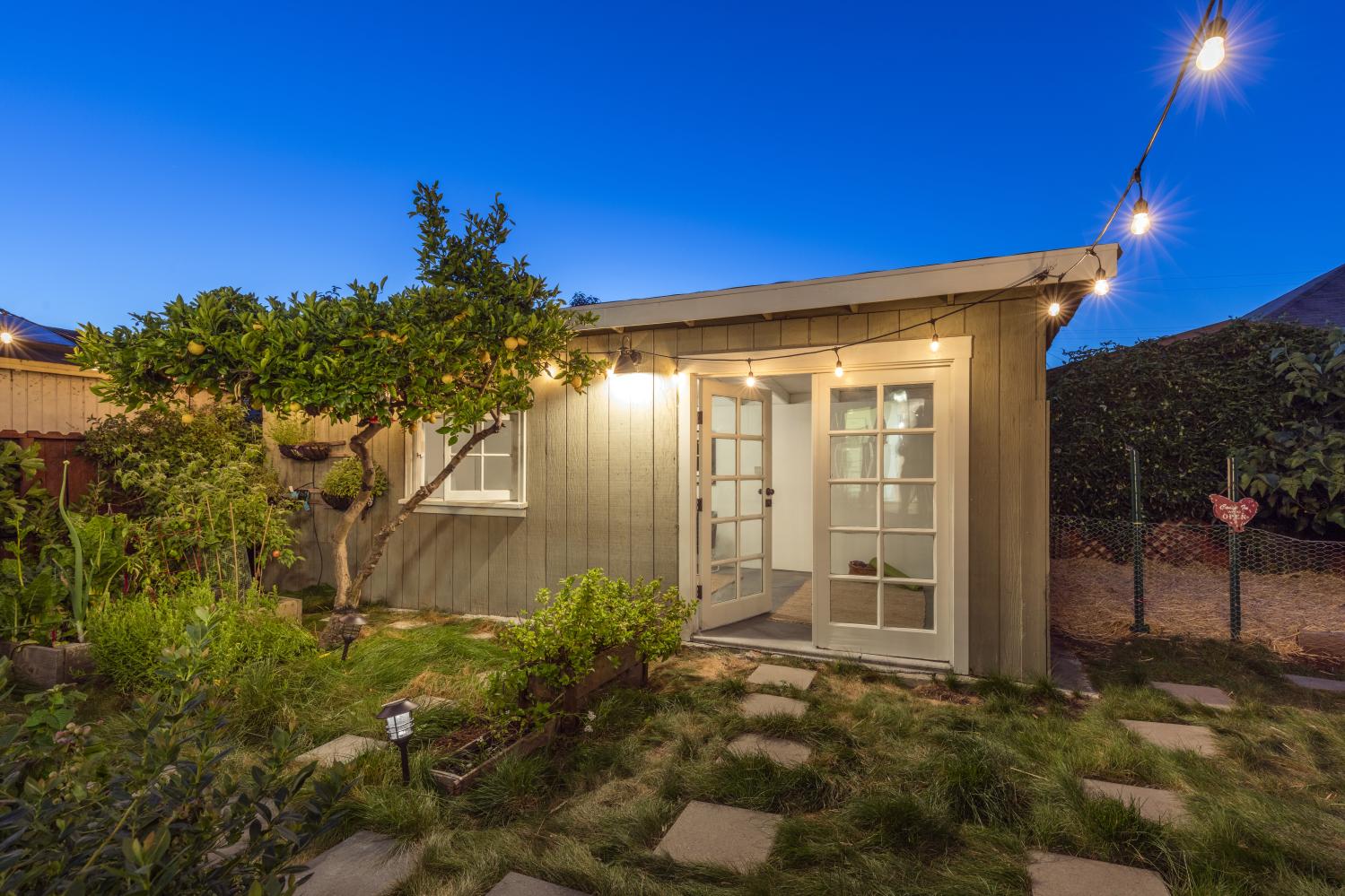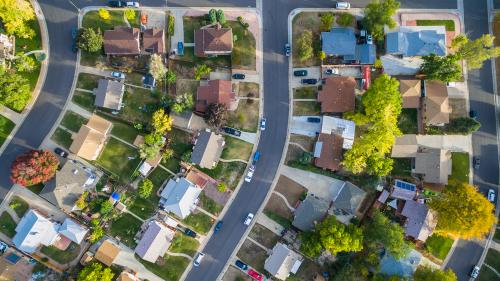Los Angeles’ housing crisis continues to worsen. In 2022, over 65,000 Angelenos were experiencing homelessness, rising to over 71,000 in 2023. Nearly 60% of renter households in Los Angeles County—over 1 million households—are cost-burdened, meaning they spend more than 30% of their income on rent. And while many public sector and nonprofit housing service providers are engaged in trying to help rehouse people experiencing homelessness, the overall number of homeless people continues to rise because high housing costs and extremely tight supply put intense financial pressure on many households.
To mitigate widespread housing insecurity, policymakers and practitioners are searching for innovative ways to expand the supply of homes affordable to low- and moderate-income households, including using new tools that statewide policy changes have created, such as accessory dwelling units (ADUs).
Over the past six years, California’s state legislature has passed a series of laws that allow ADUs in all single-family residential neighborhoods. Cities and counties are required to permit ADUs through ministerial approval (i.e., without discretionary review processes) and place guardrails on dimensional requirements. Across the state, ADU production has ramped up as architects, contractors, and other housing industry participants learn how to provide homeowners with somewhat standardized designs, financing tools, permitting, assistance, and overall project delivery. The number of ADUs permitted annually in the Los Angeles metro area rose from around 2,000 in 2017 to around 7,000 in 2019 and more than 13,000 in 2022. ADUs are more common in neighborhoods with medium to high incomes and home prices, although not in the very wealthiest communities.
A key question for state and local policymakers is: Could ADUs become a consistently used tool to deliver affordable housing for low-income residents and people experiencing housing insecurity or homelessness? In this report, we discuss why property owners build ADUs, describe the financing tools available to support ADU construction, and briefly summarize several affordable ADU pilot programs in the Los Angeles region. The analysis relies on a review of public documents and media coverage, as well as interviews with planning department staff. While this report focuses on Los Angeles, cities and states across the country are experimenting with ADU policies, and they may gain useful insights from what has—and has not—worked in California.
What motivates homeowners to build ADUs, and why would they build affordable ADUs?
Homeowners may choose to build ADUs on their property for a variety of reasons, both personal and financial. Like other types of home expansion, ADUs can provide additional space for regular use by the owner of the main property—ADUs are popular as home offices, children’s playrooms, or exercise spaces. Alternatively, an ADU may be intended to create space for guests or auxiliary household members, such as visiting family or friends, or caregivers to people living in the main home. For example, the AARP has become a strong advocate for adding ADUs to accommodate multigenerational families and caregivers for older adults.
For some homeowners, the primary attraction of building an ADU is to create an additional income source. Subject to local laws and homeowners association rules, ADUs can be listed as short-term rentals on platforms such as Airbnb or Vrbo; this may be an attractive option for homeowners who want to use the space occasionally for personal or family use while also gaining some revenue. Informal rental arrangements (absent a lease) with friends and family are also not unusual. Homeowners who commit to long-term rental contracts—generally a minimum of one year—can secure more stable, durable income, and may have lower costs from frequent turnover.
A key question for ADU owners offering longer-term leases is how to set the rent and select tenants. For policymakers who hope that ADUs can provide housing for low- and moderate-income households (generally defined as those making less than 80% of area median income), some homeowners will need to set ADU rent levels within designated ranges. As will be discussed in the next section, even if owners want to set moderate rents, they may require subsidies to cover the costs of building and maintaining an income-restricted ADU. Research finds that ADU rent levels vary widely across California, but that ADUs—most of which are modest-sized studios or one-bedrooms—are generally more affordable than other types of rental housing.
Another financial consideration is that building an ADU will likely increase the value of the overall property (the land parcel containing both the main home and ADU). Because ADUs can be used to generate income at some point in future, they should increase property values even if they aren’t currently rented out. How much value ADUs create—and the method by which properties with ADUs are assessed—is still an emerging debate among mortgage lenders and other real estate industry participants, and has important implications for debt financing.
Another key question for California policymakers is: What does increased ADU production mean for broader housing market affordability? On the most basic level, homeowners choosing to build ADUs for any reason adds to the overall stock of housing. Even if ADUs are used in the short term as home offices or for visiting relatives, they create new structures that separate households could occupy in the future. A large and growing body of research has shown that expanding the supply of housing within a neighborhood or city can help reduce upward pressure on housing costs. For example, newly built ADUs offered as Airbnbs could reduce the frequency of primary homes being listed as short-term rentals, thereby lowering the competition for those homes from owner-occupants or long-term renters.
Posed differently, can ADUs add substantially to a city’s stock of “capital-A” affordable housing, meaning that rents are set under specified limits, or occupancy is reserved for low-income households? The next section explores the financial feasibility of creating income-restricted ADUs, including the types of subsidies that could encourage affordable ADU production.
What are the economics of building income-restricted ADUs?
Most U.S. homeowners do not build their own homes; rather, they purchase an already completed house that was built by a professional developer. Adding an ADU on their property after purchase is less complex and expensive than constructing a brand new single-family home, but substantially more difficult and costly than many standard home renovations. Even with guidance from a professional contractor, architect, or consultant, homeowners must navigate a series of legal, financial, and design decisions—all of which come with price tags.
The total cost of building a new ADU in California varies widely depending on size, amenities, site characteristics, and location. Basic models around 600 square feet could be as low at $180,000, while high-end larger models can cost up to $400,000. The pre-development phase—including architectural design, structural engineering services, and obtaining required permits from local governments—accounts for roughly 10% to 15% of total costs. Hard costs—site preparation, construction materials, labor, and plumbing, electrical, and mechanical systems—account for the largest costs. A 2022 report from the University of California, Berkeley’s Terner Center estimated the average ADU cost in the Los Angeles metro area as $148,000. As with other types of housing development, construction costs for both labor and materials have risen over the past several years.
Because ADUs are a relatively new and unusual niche within housing markets, the financing ecosystem to support ADU construction and purchase is still evolving. Surveys suggest that most homeowners rely on a mixture of funding sources, including savings and bank loans, to pay for ADU development.
Purchasing a home with an existing ADU is perhaps the simplest way to access financing. The government-sponsored enterprises that securitize most home purchase loans—Fannie Mae, Freddie Mac, and the Federal Housing Administration (FHA)—have recently started taking rental income from ADUs into account when underwriting mortgages.
Financing the development of an ADU for existing homeowners is more complicated. Homeowners with high incomes, strong credit, and substantial amounts of equity in their primary residence or other financial assets have several financing options. They can borrow against their savings through a home equity loan (HEL) or home equity line of credit (HELOC), and then pay it down over time through the rental income the ADU generates. HELs and HELOCs carry higher interest rates than standard mortgages and generally have a 10-year duration to be paid off or refinanced. Alternatively, affluent homeowners can refinance their primary mortgage at an increased balance—known as a cash-out refi—and use the extra funds to construct an ADU. Compared to HELs and HELOCs, cash-out refi loans generally have a lower interest rate and offer a longer repayment period. However, rising interest rates over the past few years make this less attractive for homeowners with low rates on their primary loan. Freddie Mac offers a home renovation loan that can be used to finance a wide range of activities, including ADU construction or renovation. Fannie Mae offers a similar renovation loan product that can also be used to finance an ADU.
To reduce the costs of ADU construction for moderate-income homeowners, California offers grants of up to $40,000 for pre-development costs through the California Housing Finance Agency (CalHFA). To qualify, property owners’ household income must be less than 80% of area median income (just under $85,000 in Los Angeles County). The grants are paid directly to state-approved lenders, not to homeowners themselves. The subsidy comes from a limited pot of funds, which will be allocated until funding runs out. As described in the following section, some local governments across Southern California are experimenting with various combinations of subsidies to supplement the CalHFA grants. Some researchers have recommended tying ADU financing to receipt of federal housing vouchers, which limit renter contributions to 30% of monthly income, with the remainder paid by the federal government.
Combining ADU construction costs with the form and cost of financing allows us to see how much rental income ADU owners would need to charge to make ADU development financially feasible. Table 1 illustrates how different types of subsidies could reduce the monthly costs of ADU ownership, therefore allowing owners to charge lower rents. For simplicity, the models exclude any return on investment (profits) to the owner—essentially estimating the minimum cash flow needed to break even.
Mortgage payments represent a substantial portion of overall operating costs. CalHFA grants and similar upfront reductions in development costs bring down overall monthly costs considerably by reducing the loan amount needed (Scenario 2). Interest rate subsidies (Scenario 3) also help, but not as much as upfront grants. Combining both an upfront grant and lower interest rate (Scenario 4) lowers monthly operating costs by nearly $800 compared to completely market rate financing. For broader context, Zillow reports the median rent in Los Angeles across all property types was $2,800 as of February 2024—suggesting that even newly built market rate ADUs offer cost savings for renter households.
Whether ADU rents are “affordable” depends on the intersection between rent levels and household income. To assess whether new ADUs could be within the means of low- and moderate-income households, Figure 2 estimates the relationship between what renter households at various income levels can pay toward their housing costs (30% of monthly income) and ADU operating costs from Figure 1.
The scenario analysis suggests that newly built ADUs are a feasible housing option for middle-income renters (those earning $85,000 or more), but will require substantial subsidies to reach renters earning less than 80% of area median income (AMI). Households earning 120% of AMI can afford the monthly ADU rent under the “market rate” scenario without any subsidy. For households at 100% of AMI, the market rate rent is slightly beyond their estimated capacity to pay, while all three subsidy scenarios would put ADU rent within reach. Making ADU rents affordable to households earning 50% or 80% of AMI would require both upfront development grants as well as ongoing low interest rates (or other forms of operating subsidies, such as housing vouchers).
The bottom line is that making newly constructed ADUs affordable to low- or moderate-income tenants runs into a basic math problem. Homeowners who plan to rent out ADUs at prevailing market rents can finance the upfront construction through existing sources such as home equity loans or cash-out refinances, then pay down those loans from the rental income the ADU generates. For income-restricted ADUs, however, tenants are not able to pay enough to cover the monthly operating costs. Homeowners who are willing to rent to low-income tenants will require substantial subsidy to make developing ADUs feasible in the first place.
How are localities across Southern California incentivizing affordable ADUs?
To understand how local governments are trying to encourage production of affordable ADUs, Figure 3 summarizes the financial framework of several pilot programs across the region. More detailed program descriptions are provided in the Appendix. In this report, we focus on the structure of subsidies; future reports will discuss the programs’ development and operations in more depth, as well as market factors and institutional support that affect program outcomes.
The four featured local governments have designed affordable ADU programs with somewhat different upfront subsidies, but largely similar operating subsidies. The programs also vary in the duration of commitment required from participating homeowners.
Los Angeles County, Pasadena, and West Hollywood offered low-cost loans or grants for upfront development to incentivize property owners to create income-restricted ADUs. The terms of these loans are very generous to borrowers: interest rates that are well below market rates and deferred loan repayment, which should attract homeowners to participate while lowering the monthly rent needed to cover operating costs. The Pasadena and West Hollywood programs were designed as revolving loan funds, with the goal of having property owners pay off construction loans through refinancing after three years. Los Angeles County’s program was designed as a forgivable no-interest loan—essentially a grant, as long as homeowners remain in compliance. The LA ADU Accelerator Program had a different focus: encouraging owners of existing ADUs to rent to low-income tenants in exchange for guaranteed rent payments covered by the city, plus assistance in finding and screening tenants.
All four programs recognize the need for ongoing subsidy to cover the gap between what low-income renters can afford to pay and ADU owners’ operating costs. The three new construction programs—in Los Angeles County, Pasadena, and West Hollywood—provide federal housing vouchers to tenants in affordable ADUs, while the city of Los Angeles uses philanthropic funds to pay an equivalent amount toward rent (tenants pay 30% of income and the city covers the remainder up to a designated rent cap). All the programs emphasize that this structure reduces the effort needed from ADU owners; city agencies or contractors do the work of finding and screening income-eligible tenants, as well as annual income certifications that are required for federal voucher recipients.
To date, these programs have resulted in fewer than 10 newly built affordable ADUs across three jurisdictions (Los Angeles County, Pasadena, and West Hollywood), and support about 25 low-income renter households in existing ADUs in the city of Los Angeles. Most of these programs were designed as small-scale pilots to test the viability of the concept before committing to longer-term funding. Future reports will discuss some of the market challenges in scaling up, including rising interest rates and construction costs.
Like other forms of affordable housing, income-restricted ADUs will require ongoing subsidies
State and local policymakers across Los Angeles and other California communities are searching for new tools to address the state’s persistent housing shortage, and particularly to support low-income renters. Over the past several years, new state laws have led to increased production of ADUs, which homeowners develop either to expand their own living space or as a source of additional income.
Financial models of ADU development suggest that newly built ADUs can offer relatively affordable rental housing to middle-income renters in Los Angeles compared to other types of rental housing in the region. However, because of high construction costs, making newly built ADUs affordable to low- and moderate-income households will require considerable subsidy of both upfront development and ongoing operations.
Local governments across the Los Angeles metro area are experimenting with various pilot programs to encourage affordable ADU development, which provides useful insights into the effectiveness of different types of subsidies. Future research will examine market and policy factors that support or hinder affordable ADU production, and will consider how ADUs fit into the larger ecosystem of affordable housing in the region.
Appendix: Profiles of selected affordable ADU pilot programs
-
The LA ADU Accelerator Program
Los Angeles’ ADU Accelerator Program was created by the city’s Housing and Department in partnership with the LA Bloomberg Innovation Team, with the goal of increasing affordable rental housing for older, low-income residents. In 2018, the city received $1 million in funding from Bloomberg Philanthropies, which it used to subsidize rents for tenants and cover program operating costs.
Single-family and multifamily property owners with an existing, legally permitted ADU and a certificate of occupancy or a certificate in progress could apply to the city to be matched with a tenant. Owner occupancy is not required. The financial incentive for homeowners is guaranteed rent paid by the city, free case management, and free screened tenant placement. The city does not offer a construction subsidy, as program leaders feel it is more cost effective to subsidize rent in existing ADUs than pay for new ones.
Los Angeles residents over age 61 who make 30% or less of the area median income could apply to the program to be matched with a homeowner. The tenant committed to renting that ADU for five years, which provides stable rental income and minimal turnover for the homeowner. Participating property owners also have to commit to renting to the tenant for five years. The program has seen minimal turnover of tenants or homeowners. Tenants contribute 30% of their income toward rent, and the city pays the remainder to the homeowner using the philanthropic funding (functionally similar to federal housing vouchers).
Applications for the program opened in 2020, and the program housed 32 older adults in 25 ADUs as of 2021. The program is no longer accepting applications, but may open applications in the future depending on funding and political will.
-
Los Angeles County Second Dwelling Unit Pilot Program
The Los Angeles County Second Dwelling Unit Pilot Program was created by the Los Angeles County Development Authority (LACDA) in 2018 with the goal of increasing affordable rental housing. The county allocated funds for construction loans to homeowners that agreed to build ADUs designated for people experiencing homelessness. The funding came from the County Executive’s Homeless and Housing Funding program budget. This was part of the county’s larger initiative to increase affordable housing in single-family neighborhoods.
Single-family property owners could apply to the county for a forgivable loan of $75,000 to construct an ADU. Homeowners could also apply for a $50,000 grant from the city to preserve existing unpermitted ADUs. Participating homeowners would also receive free project management through the city’s outside consultant to navigate the development process, including design, permitting, and construction.
Completed ADUs would be occupied by renters previously experiencing homelessness. Participating property owners must commit to renting to a recently homeless tenant for 10 years.
Los Angeles County’s pilot program opened for applications in 2018. One unit was completed in 2021 and two others are still in progress. The program no longer exists, but county supervisors passed a motion in 2022 to create a permanent program with similar financial incentives and outcomes.
-
Pasadena Second Unit ADU Program
The Pasadena Second Unit ADU Program was created by the city’s Department of Housing in 2020 with the goals of increasing affordable rental housing, improving the quality and safety of existing unpermitted ADUs, and supporting a source of additional income for less affluent homeowners. The city allocated funds for two types of loans: construction loans for new ADUs designated for low-income renters, and rehab loans for existing unpermitted ADUs. Residents in Community Development Block Grant-eligible census tracts were given priority for both loans.
Single-family property owners could apply to the city for a three-year construction loan of up to $200,000 carrying a 1% simple interest rate—well below typical construction loan rates. Owners of an existing unpermitted ADU could apply for a $100,000 loan to bring their ADU up to code. Payments were deferred for the first three years. These loans also carry a 1% simple interest rate over a 20-year term. Single-family property owners applying for a new ADU must demonstrate owner occupancy for the previous two years. Applicants for unpermitted ADUs must demonstrate current owner occupancy of the main building and the ADU must currently have or previously have had tenants.
The program was intended to function as a revolving loan fund; once the ADU was completed, the goal was for property owners to refinance into a permanent loan and repay the city’s construction loan, freeing up funds for another project. Participating homeowners would also receive free project management through the city’s outside consultant to navigate the development process, including design, permitting, construction, and lease-up.
Completed ADUs would be occupied by low-income renters who receive federal housing choice vouchers, selected from those already on Pasadena’s voucher wait list. Matching households from the wait list to newly created affordable ADUs makes it easier for property owners to participate, because they do not have to search for renters or verify their income. Participating property owners must commit to renting to a voucher holder for seven years.
Pasadena’s pilot program opened for applications in 2020. Two new ADUs were created and two unpermitted ADUs were brought up to code. The program is currently not accepting applications. Applications will tentatively reopen in spring 2024, and the city plans to increase the number of ADUs for the second round.
-
West Hollywood Affordable ADU Pilot Program
The West Hollywood Affordable ADU Pilot Program was developed by the city in 2022 with the goal of increasing affordable rental housing. The city allocated funds for construction loans to homeowners that agreed to build ADUs designated for low-income renters.
Single-family and multifamily property owners could apply to the city for a three-year construction loan of up to $150,000 carrying a 1% simple interest rate—well below typical construction loan rates. Payments were deferred for the first three years. Single-family property owners must demonstrate owner occupancy for the previous year, but owner occupancy is not required for multifamily units. The program was intended to function as a revolving loan fund; once the ADU was completed, the goal was for property owners to refinance into a permanent loan and repay the city’s construction loan, freeing up funds for another project. Participating homeowners would also receive free project management through the city’s outside consultant to navigate the development process, including design, permitting, construction, and lease-up.
Completed ADUs would be occupied by low-income renters who receive federal housing choice vouchers, selected from those already on West Hollywood’s voucher wait list. Matching households from the wait list to newly created affordable ADUs makes it easier for property owners to participate, because they do not have to search for renters or verify their income. Participating property owners must commit to renting to a voucher holder for seven years.
West Hollywood’s pilot program opened for applications in 2022. Two units are currently under construction. The city council plans to discuss establishing the program on a long-term basis.
-
Acknowledgements and disclosures
Funding for this research was provided by the Hilton Foundation. We appreciate the time and expertise shared by staff at Los Angeles County Development Authority, Pasadena Department of Housing, the West Hollywood Economic Development Department, and the Bloomberg Center for Public Innovation at Johns Hopkins University. Nick Marantz and Kevin Park provided thoughtful comments. Any errors or omissions are the responsibility of the authors.





